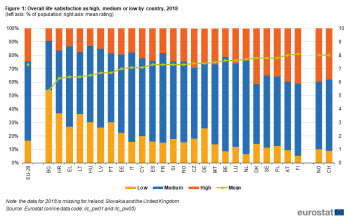- Data from Month YYYY. Most recent data: Further Eurostat information, Main tables and Database. Planned article update: (dd) Month YYYY(, hh:00).
The article presents the result from the pilot data collection on regional business demography in the European Union (EU). The European Commission needs regional business demography to better assess and monitor the quality of the business environment in the regions of the European Union. A substantial share of Cohesion Policy funds (350 billion Euro between 2007-2013) was dedicated for improving the business environment and entrepreneurship. In particular, Cohesion Policy targets to support SMEs and newly born businesses, to boost their growth and the innovative capacity. Given the regional nature of most of Cohesion Policy programmes, regional business demography indicators would reveal where most new businesses are created and how quickly firms grow.
Regional Business Demography 2012 data collection followed an explicit request made by Directorate-General for Regional and urban Policy (DG REGIO) to Eurostat. The pilot exercise intended to test the feasibility of the most detail level of regional breakdown (NUTS 2 and NUTS 3) of already available national business demography data for the reference years 2008, 2009 and 2010. Luxembourg, Cyprus and Malta are not concerned, as they consist of only one NUTS 3 region (or two in the case of Malta).
Eleven countries participated based on grant agreements (Bulgaria, Denmark, Spain, France, Hungary, Austria, Romania, Slovenia, Slovakia, Finland and the Nederland) and six countries on a voluntary basis (Czech Republic, Italy, Lithuania, Poland, Estonia and Portugal).
Main statistical findings
Highlights
- Business demography statistics at the country level can hide substantial differences between regions.
- Significant regional differences exist mainly in the smaller economies, although for France, Italy and Spain sizeable regional differences also exist in death rates.
- Within large economies, differences in the rates of births and deaths of enterprises are driven mainly by micro firms.
- Birth rates of enterprises tend to be higher in the capital region compared to the national average, while death rates are typically closer to the average.
Birth rate
The birth rate of enterprises at NUTS 3 level for the reference year 2010 and for the total business economy of NACE Rev.2 (section B to S, excluding section O and group K642) is presented in Table 1. The results are promising with plausible trends at the regional level. For example, birth rates of enterprises tend to be higher in (or around) the capital region and in regions with a significant tourism industry (Algarve in Portugal and along the South coast of Spain). In Austria and Italy, the birth rates were particularly low. In other countries, there are also large regional differences, though in some cases this is mainly due to a single region, such as the highest rate of Ilfov in Romania, Varna in Bulgaria and in Denmark: Byen Kobenhavn (with a high rate) and Bornholm (a low rate).
Subdivision 2
Subdivision 3
Data sources and availability
<description of data sources, survey and availability (completeness, recency) limitations>
Context
<context of data collection and statistical results: policy background, uses of data, …>
See also
- Name of related Statistics Explained article
- Name of related online publication in Statistics Explained (online publication)
- Name of related Statistics in focus article in Statistics Explained
- Subtitle of Statistics in focus article=PDF main title - Statistics in focus x/YYYY
Further Eurostat information
Data visualisation
- Regional Statistics Illustrated - select statistical domain 'xxx' (= Agriculture, Economy, Education, Health, Information society, Labour market, Population, Science and technology, Tourism or Transport) (top right)
Publications
Publications in Statistics Explained (either online publications or Statistics in focus) should be in 'See also' above
Main tables
- Title(s) of second level folder (if any)
- Title(s) of third level folder (if any)
Database
- Title(s) of second level folder (if any)
- Title(s) of third level folder (if any)
Dedicated section
Methodology / Metadata
<link to ESMS file, methodological publications, survey manuals, etc.>
- Name of the destination ESMS metadata file (ESMS metadata file - ESMS code, e.g. bop_fats_esms)
- Title of the publication
Source data for tables, figures and maps (MS Excel)
Other information
<Regulations and other legal texts, communications from the Commission, administrative notes, Policy documents, …>
- Regulation 1737/2005 (generating url [http://eur-lex.europa.eu/LexUriServ/LexUriServ.do?uri=CELEX:32005R1737:EN:NOT Regulation 1737/2005]) of DD Month YYYY on ...
- Directive 2003/86/EC (generating url [http://eur-lex.europa.eu/LexUriServ/LexUriServ.do?uri=CELEX:32003L0086:EN:NOT Directive 2003/86/EC]) of DD Month YYYY on ...
- Commission Decision 2003/86/EC (generating url [http://eur-lex.europa.eu/LexUriServ/LexUriServ.do?uri=CELEX:32003D0086:EN:NOT Commission Decision 2003/86/EC]) of DD Month YYYY on ...
<For other documents such as Commission Proposals or Reports, see EUR-Lex search by natural number>
<For linking to database table, otherwise remove: {{{title}}} ({{{code}}})>
External links
Notes
[[Category:<business demography>|Business demography - regional analysis]] [[Category:<structural business statistics>|Business demography - regional analysis]] [[Category:<statistical article>|Business demography - regional analysis]]

